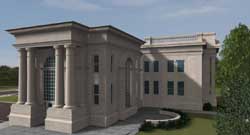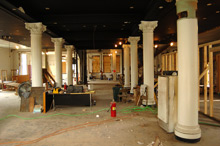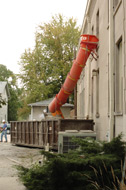Major Renovation of Emison Art Center Will Create a 'Teaching Museum' at DePauw
September 23, 2004
 September 23, 2004, Greencastle, Ind. - DePauw University's Emison Art Center will become a "teaching museum" that will benefit faculty members, students and the community, DePauw President Robert G. Bottoms said today as he outlined plans for a renovation of and addition to the historic art building located at College and Simpson streets. Although University officers are still working to secure additional gifts to support the project, President Bottoms said the University has received sufficient funds to allow construction to begin. Groundbreaking for the $6.5 million project is under way. (at left: architect's rendering)
September 23, 2004, Greencastle, Ind. - DePauw University's Emison Art Center will become a "teaching museum" that will benefit faculty members, students and the community, DePauw President Robert G. Bottoms said today as he outlined plans for a renovation of and addition to the historic art building located at College and Simpson streets. Although University officers are still working to secure additional gifts to support the project, President Bottoms said the University has received sufficient funds to allow construction to begin. Groundbreaking for the $6.5 million project is under way. (at left: architect's rendering)
"I want particularly to thank James W. Emison, a 1952 DePauw graduate and a member of the family for whom the art center is named; Arthur E. Klauser, a 1945 DePauw graduate; Richard D. Wood, a 1948 DePauw graduate; and other donors who wish to remain anonymous, for their support of this project.  Their leadership is invaluable in helping DePauw begin to further strengthen the teaching and learning of art at DePauw for generations of students to come," says President Bottoms.
Their leadership is invaluable in helping DePauw begin to further strengthen the teaching and learning of art at DePauw for generations of students to come," says President Bottoms.
The refurbished Emison Art Center will serve as a home for the University's Shidzuo Iikubo Museum and its Arthur E. Klauser Asian and World Community Collection, a gallery for the Vandiver-Haimann Collection of African Art, curated exhibits from DePauw's permanent art collection, and touring exhibits and special exhibits from the Indiana Museum of Art, Indiana State Museum, Indiana Historical Society and other organizations.
"The concept of a teaching museum is that we will make regular use of the University's art collection for  classes and student projects. Having faculty offices, seminar rooms, meeting areas and archival study spaces located in the Emison Art Center means that faculty members and students will have regular interaction with art collections and exhibitions," Dr. Bottoms adds.
classes and student projects. Having faculty offices, seminar rooms, meeting areas and archival study spaces located in the Emison Art Center means that faculty members and students will have regular interaction with art collections and exhibitions," Dr. Bottoms adds.
"Currently, we are able to provide access to less than one-third of the University's permanent collection because of limited space available in Harrison Hall," notes Neal B. Abraham, executive vice president, vice president for academic affairs and dean of the faculty. "The Emison Art Center as a teaching museum will allow greater display and access for faculty members and students to support their study and research projects. It also means that more of the University's art and special exhibits will be available for viewing by members of the community, Dr. Abraham noted. DePauw's art exhibits are open and free to the public.
The plans for renovation of and addition to Emison Art Center include:
- A new, formal entrance wing facing Seminary Street that will include accessibility for handicapped persons. The new entrance will be balanced by the completion of the balustrade on the original building to enhance the aesthetic appeal of the renovation.
- Additional visitor parking on the northeast side of the building.
- Additional, permanent gallery space for DePauw and other art exhibitions.
- Faculty offices, meetings spaces and seminar rooms on the second floor.
- A complete overhaul of the heating and air conditioning system in order to provide museum-quality climate control and light regulation.
- Archival research facilities to permit students and faculty members to
 work with items not on display.
work with items not on display.
The Emison Art Center was originally the University library named for Andrew Carnegie when it was built in 1908 with the help of a $50,000 grant from the famed industrialist (read more here). It was designed by Indianapolis architect Oscar Bohlen. Constructed entirely of Bedford, Indiana, limestone, the building featured four Ionic columns at both the front entrance on the west side and facing East College on the south side. The building was converted to use as the center for teaching studio art and history of art in 1958 with the opening of Roy O. West Library, and a new south entrance was added. Those functions recently were moved to the University's new Peeler Art Center, which opened in the fall of 2002.
The building was renamed the William Weston Clarke Emison Art Center in 1986 to honor the contributions of generations of the Emison family to DePauw.
Back